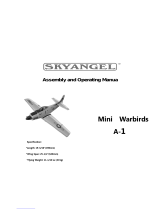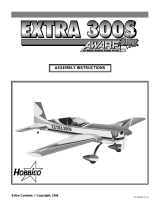Page is loading ...

Assembly and Operating Manual


Assembly and Operating Manual
Dear customer,
Congratulations on your choice of a
factory-assembled model aircraft from the
SKYANGEL Hummingbird range and thank you
for placing your trust in us.
Very little preparation work is required to get this
model ready to fly. To operate your new model
safely it is important that you read through all of
the instructions and safety information included
with your model, before you fly it for the first time.
The illustrations in this manual show the Red
version of the model with factory applied decals.
The power system
The model is powered by a brushless outrunner
motor and ducted fan, both of which are
factory-installed on the Ready-To-Fly version.
The motor is connected to the electronic speed
controller which is factory calibrated on the
Ready-To-Fly version. All that is required is to
charge the Li-Po battery, following the safety
instructions, and connect battery to the electronic
speed controller.
Switch off in the reverse order: disconnect the
battery from the electronic speed controller first,
and then switch off the transmitter.
The radio control system
To fly the RED ARROWS you will need a radio
control system with at least four channels. 2.4GHz
radios systems are recommended, similar to the
unit included with our deluxe version.
The servos for the ailerons and the elevators are
factory-installed.
The power for the receiver is drawn from the
electronic speed controller’s integral BEC system.
The electronic speed controller is located inside of
the fuselage, in front of the ducted fan.
To check the model’s operating systems, first set
the control surface servos to neutral, with the
transmitter sticks and trims at centre.
When you wish to fly the model, always make sure
the transmitter is in the “OFF” position. Move the
throttle stick to the “OFF” position as well. Then
connect the flight battery to the electronic speed
controller.
Glued joints, suitable adhesives
Foam safe epoxy is recommended and available
from most reputable model retail shops.
Trial-fit all parts “dry” before applying glue.
Follow the recommended curing time suggested
by the glue manufacturer. Allow the glue to fully
cure (harden) to the point where the joint can be
placed under stress.
Kit contents
Fuselage, with motor, electronic speed controller
and servo
Clear canopy and cockpit
Main wing panels with ailerons and servo
Left / right tail plane panels with elevators and
vertical stabilizer
Accessories
1 x Li-Po battery, 3s 850mAh 20C
1 x 20A Brushless ESC (Electronic Speed Controller)
3

Parts List
NO. Description
1 Fuselage
2 Wing Set – One Main Wing Panel
3
Tail Set - One Left (and one Right) Horizontal Stabilizer with
Elevator
4 Tail Set - One Vertical Stabilizer
5 Cockpit Canopy
6 Missiles
7
Radio Control Transmitter (we highly recommend 2.4 GHz
system)
8 Balance Charger
9 850mAh 11.1 Volt 20C Li-Po Battery
10 Landing Gear set
11 Landing Gear Fixed Plate set
12 Scale
Assembly and Operating Manual
4
Fig. 1 Open the box an
d check all the parts.
Parts Illustration

Assembly and Operating Manual
5
Fig. 2 - Glue the horizontal stabilizers to the slots
at the rear of the fuselage (glue not included).
Fig. 5 - Glue to the wing panel to the fuselage
(glue not included).
Fig. 3 - Remove any excess glue and hold in
position until glue sets. The photo shows the
finished view.
Fig. 6 –Photo shows the finished view after wing
panel assembled.
Fig. 4 - Tight the set screws on the elevator EZ
connectors.
.
Fig. 7 - Locate the fixed plate for the front wheel.

Assembly and Operating Manual
6
Fig. 8 - Glue the fixed plate into the fuselage as
shown in the photo (glue not included).
Fig. 11 –Photo shows the finished view .
Fig. 9 - Attach the front wheel to the fixed plate
Fig. 12 - Attached the rear wheels to the fixed
plate units on each side of the main wings.
Fig. 10 - Glue the main wheel fixed plate to the
slot on one half of the main wing panel.
Fig. 13 –Painted missile
s, for extra realism, are
included. Cut ap
art for assembly as shown.

Assembly and Operating Manual
Fig. 14 - Glue missiles into the main wing slots
(glue not included).
Fig. 17 - Remove any excess glue and hold in
position until the glue sets. The photo shows the
finished view.
Fig. 15 –Photo shows missiles in attached position
Fig. 18 - Connect the electronic speed controller
and servos to the receiver. Refer to the radio
instructions for the correct channel sockets and
servo lead polarity.
Fig. 16 –Glue the vertical stabilizer as shown in
the photo (glue not included).
Fig. 19 - Locate the battery and can
opy
. Charge
the battery according to the safety instructions
before installing.
7

Assembly and Operating Manual
8
Fig. 20 - Photo shows battery leads connected to
the electronic speed controller.
Fig. 23 - Congratulations, you have completed
the assembly process. We hope you enjoy flying
your new model!
Fig. 21 - Insert the battery into the front of the
fuselage.
Fig. 24 - Charge the flight battery; connect the
Equalizer lead using and
adapter lead matching
your charger (adapter lead not included)
Fig. 22 - The canopy is held in place by magnets
and can be lifted off.
Fig. 25 - Switch the transmitter on, and move th
e
throttle stick to the “Motor OFF” position. (Diagram
MODE 1 right throttle control stick)

Assembly and Operating Manual
- Pull the elevator stick back towards yo
u (c), and the
trailing edge of both elevators should rise (c).
- Check that the control surfaces respond to the appropriate
movements of the transmitter sticks. If not, swap over the
connectors at the receiver.
- Check the neutral position of the control surfaces; you may
need to screw the clevises in or out to correct any discrepancy.
- Open the throttle (stick forward): the motor should now run,
and you should feel a strong air flow rushing out from the tail
end of the model.
- Remove any loose objects such as cloths, tools, etc from the
area in front of the model, as they could easily be sucked into
the ducted fan.
- If either function works in the wrong way, correct it using your
transmitter’s servo reverse facility for that channel.
- Move the aileron stick to the right (a), and the right aileron (a)
must rise up, the left aileron (b) fall down.
- Disconnect the battery from the electronic speed controller and
then switch the transmitter of
- Move the throttle stick back to the “Motor OFF” position.
Fig. 26 and 27 - Checking Ailerons and Elevators
- Check the direction of rotation of the servos:
Fig. 28 - Checking the power system
- Hold the model securely.
- Stand behind the model.
9

Assembly and Operating Manual
Fig. 29 - Checking the model’s balance
- Place the flig
ht battery in its compartment, without connecting.
- Mark the Centre of Gravity (CG) on both sides of the fuselage; the position
is shown in the photo.
- Support the model at the marked points and allow it to hang freely. When
correctly balanced the airplane will remain horizontal, with the nose
slightly down.
- If necessary, adjust the position of the flight battery to achieve the correct
CG.
- Mark the battery location in the fuselage, so that you can be sure of
positioning it correctly after recharging.
- Pack scrap pieces of foam around the battery in its final position,
otherwise there is a danger of it shifting in flight and altering the model’s
balance.
- Char
ge the flight battery and the model is ready for flight.
Fig. 30 - Access to the
ducted fan unit and electronic speed controller
- The ducted fan unit is accessible from underneath, if you need to carry out
maintenance work or repairs.
- Ensure that the wire colors match correctly.
10

Assembly and Operating Manual
Test Flying - Notes on flying the airplane
Please read the sections entitled “Routine pre-flight checks” and “Flying
the model” in the Safety Notes before attempting to fly the RED ARROWS
for the first time.
- For the first flight you sho
uld wait for a relatively calm day with no more
than a gentle breeze.
- A good flying site is a large, flat, open field; well away from trees, fences,
high-tension overhead cables and other potentially dangerous obstacles.
- Carry out a complete check of the working systems.
- We recommend that you ask an experienced modeler to help you initially;
to give the model a fairly powerful hand-launch.
- The model must be launched directly into any existing wind.
- Switch the motor on, and launch the airplane strongly into the wind, with the
fuselage and wings level.
- Allow the L39 Jet to fly straight and level initially; don’t try to turn it when it is
close to the ground.
- Adjust the trims if necessary so that the model settles into a steady climb.
- Check the model’s response to control commands from the transmitter. You
may need to increase or reduce the control surface travels once the model
is back on the ground.
- Take the airplane up to a safe height and check its stalling speed.
- Keep the speed well up on the landing approach to avoid stalling.
- If you had to move the trims during the flight, correct the mechanical
linkages before flying again. This allows you to re-centre the trims, so that
full trim travel is available for subsequent flights.
- We reserve the right to introduce technical modifications and suggest that
you check our website for updates.
11

Jiangyin Skyangel Electronic Technology Co., Limited.
5th Floor, A3 Building, Xinjianxing Technology Industrial Park, Fengxin Road,
Guangming Town, Bao'an, Shenzhen City, 518107 China
Phone: +86 755 33699201
Fax: +86 755 33699203
www.skyangelrc.com
/

